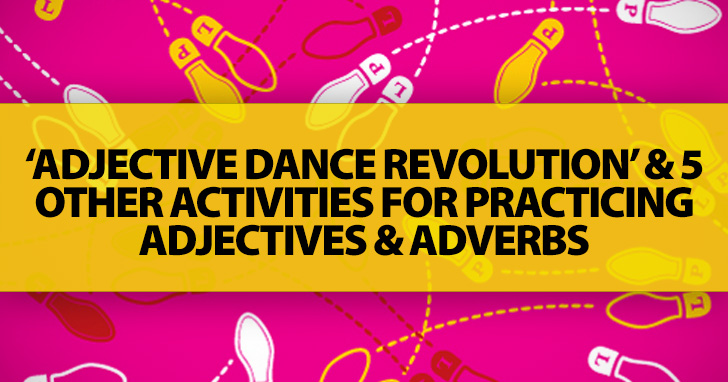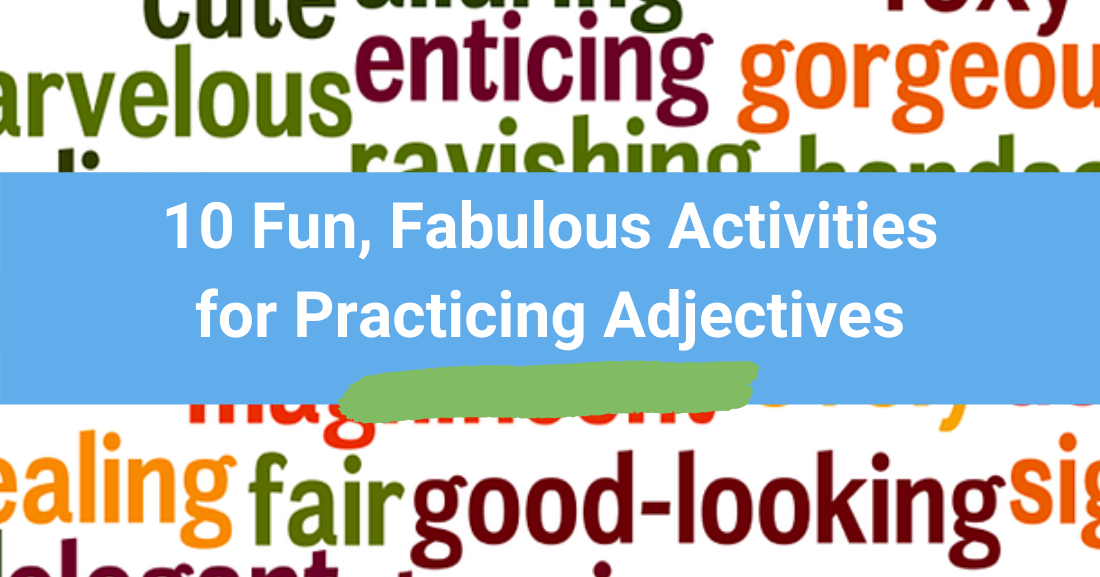'Adjective Dance Revolution' And 5 Other Activities For Practicing Adjectives And Adverbs



Here are some easy activities for practicing adjectives or doing a quick review.

Have your students create their own Bingo boards for an adjective review game. Give students a blank bingo board and some old magazines. Students should cut pictures of people out of the magazine, one for each blank on the bingo board, and glue them in place however they see fit. Students should use a variety of different pictures and different people. Once the glue dries, it’s time to play human adjective bingo. To play, call out different adjectives that can describe people. If a picture on their board matches that description, they can cover the square. When someone calls bingo tell your class to keep their markers in place. The class will have to agree that the people and adjectives match to win the game.
Depending on the personality of your class, you can play bingo using the pictures of your students on a blank bingo board in place of pictures from a magazine. Start by giving each person a blank bingo board, and ask them to fill in the spaces with adjectives that might describe a person. Then, instead of pulling adjectives randomly, show random pictures of your students (one person per photo) as well as other teachers and students they might know going about their usual (or unusual) activities. If you take pictures of special events or classroom activities, this game is a great way to make them work double duty.
Divide your class into two (or more) teams to play this adjective elicitation game. One at a time, students come to the front of the room. (If possible, you may want to put some type of divider between the students or use an easel so neither person can see what the other writes.) To play one round, show the two students (and your class) a picture. For the next sixty seconds, each person must write down as many adjectives to describe the picture as he or she can think of. At the end of the minute, have students compare their lists. Any word both students listed gets crossed off. Each student gets one point for every remaining adjective and minus one point for every word which is not an adjective for his team. Continue until everyone has had a turn up front. The team with the most points wins the game.
To play this adjective review game, you or your students will need to create a deck of adjective cards. You can use index cards or upcycle an old deck that may be missing a card or two. To prep the game, simply write a different adjective on each card. To play, each person starts with a picture. You might want to choose pictures for your students or have them choose their own. You can use magazine pictures, travel brochures, pictures printed off the internet, or have students bring in pictures they have taken themselves. Each person lays the picture in front of him so he and the other players can easily see it. Then, the dealer gives each person four cards and turns the first card over to make a discard pile. The goal is to get four cards, and therefore four adjectives, that describe the picture in front of you. On each turn, pick up one card either from the draw pile or the discard pile. Then discard one. (Play is similar to Gin Rummy.) The one who gets four cards that describe his picture wins.
Can a match made in heaven happen in an ESL class? Your students will be able to answer that question at the end of this activity. Each person in class will play matchmaker for an unattached friend or family member. Each person starts by making a list of adjectives which describe her single friend. The adjectives should describe appearance and personality (both good and bad), and students should also list likes and dislikes for their friend. Then, students go around the room asking questions about their classmates’ single friends. The matchmaker’s goal is to find someone who is similar to his friend and who he thinks would be a good match. When students think they have found one, they should show you the two profiles and see if you agree.

In this creative activity from teachthis.com, students will work together to create a letter from a pen pal. Divide your class into groups of eight, and make a copy of this blank pen pal form for each student. Students start by filling in the blanks of the first sentence, which gives a name and age for the pen pal. Then they should fold over the top of the paper so no one can see what they wrote. Everyone passes their papers to the person on their right and then fills in the next sentence which describes what the person looks like. Again, students fold down the top of the paper to hide what they have written before passing it to the right again. Continue in this manner, filling in the blanks, folding the top of the paper down, and passing the paper to the right until all of the sentences on each sheet are complete. Pass the paper one more time and have students unfold it to reveal the letter from their pen pal. Be prepared for some entertaining combinations of descriptive adjectives.
This activity will help your students understand how similar adjectives can have different degrees of intensity. To prepare, take a trip to your local hardware store or anyplace else where they sell wall paint. Gather several paint sample cards which have two or more shades from the same family. In class, give your students a pair of adjectives which have similar meanings but are of different intensity. For example, you might use any of the following pairs:
If you don’t make a display with the cards from the previous activity, use them to create a set of adjective dominoes. Have students cut each paint sample into two equal pieces so each adjective is on its own piece. Then, have students tape two pieces from different cards together domino style. Play a game of dominoes following the standard rules, but instead of matching numbers match each adjective to its more or less intense partner.
This simple activity not only reviews adjectives with your students but gives them practice putting them in the right order. Start by writing a simple sentence on the board. (The boy is holding a book.) Tell your students that adjectives make a sentence more interesting by giving details. Challenge your students to add adjectives to the sentence you have on the board, one at a time, to make a more interesting sentence. As they add adjectives, point out the correct order in which to place them. (For a simple summary of how to order adjectives, see this adjective lesson plan on learn4good.com.) Once students are familiar with the process, put them in pairs and give them some additional simple sentences. Give students a few minutes to expand their sentences as creatively as possible and then come back together as a class to share what students have written.

In this adjective activity, your students will have a chance to be creative and imaginative. Give each student two sticky notes. On one note they should write a noun and on the other an adjective. Encourage students to be creative. Then, have students mingle around the classroom. During this time, they should look at what every other student has written on his sticky notes. The challenge is to use either another student’s adjective with her noun or the other student’s noun with her adjective and put the two together in a creative sentence. Partners can work together to write one sentence when they are matched, and both should write it on their paper next to their partner’s name. Continue the mix up until every student has worked with every other student to write a sentence using these creative words. If you like, have individuals share their favorite sentences with the rest of the class before collecting and checking what students came up with.